June 18, 2025 | 03:22 GMT +7
June 18, 2025 | 03:22 GMT +7
Hotline: 0913.378.918
June 18, 2025 | 03:22 GMT +7
Hotline: 0913.378.918
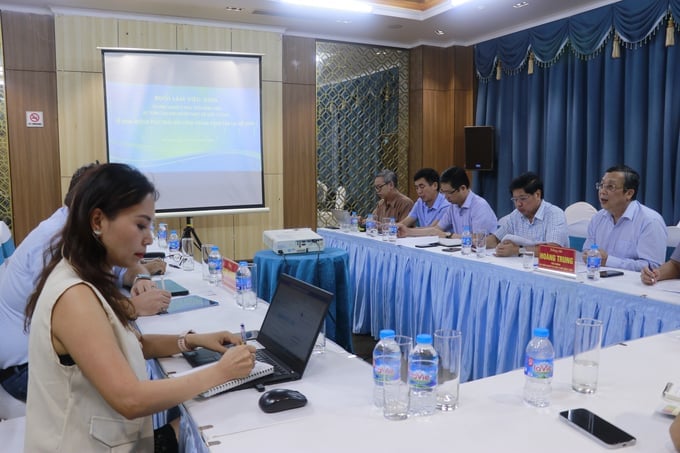
The Ministry of Agriculture and Rural Development held a meeting with the International Center for Tropical Agriculture (CIAT) to discuss sustainable development strategies for the cassava industry. Photo: Thanh Tien.
The meeting focused on promoting sustainability in cassava production in Vietnam, with goals including maintaining production area, increasing production, improving quality, and minimizing pests and diseases. The Ministry is also developing a collaborative program with CIAT for the years between 2025 and 2030.
According to the Food and Agriculture Organization, as of 2022, Vietnam ranks ninth globally in terms of cassava production area and seventh in yield.
Vietnam experienced a decline in both cassava production area and yield between 2015 and 2023, with an average annual decrease of 1.1% and 0.11%, respectively. Accordingly, the average cassava yield reached approximately 10.6 million tons, whereas the production area fluctuated between 500,000 and 550,000 hectares annually.
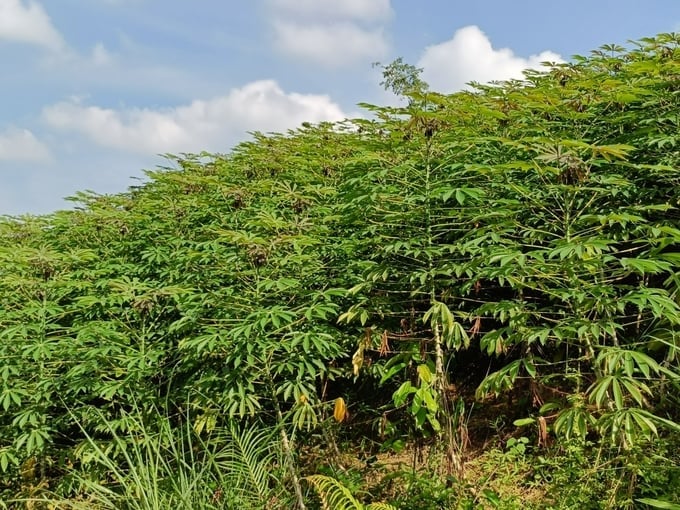
Cassava production area in Vietnam fluctuates between 500,000 and 550,000 hectares annually. Photo: Thanh Tien.
Vietnam’s cassava production averages at 19 to 20 tons per hectare, placing it fifth among the ten largest cassava-producing countries. With an ongoing upward trend, Vietnam's cassava production is currently equal to that of Thailand and 73% that of Cambodia.
According to the Department of Crop Production, as of 2023, cassava is grown across five ecological regions in Vietnam:
- The Northern Midland and Mountainous region houses over 100,000 hectares of cassava production area, with a total yield of 1.3 million tons. Local cassava production areas are located in the provinces of Son La, Yen Bai, Dien Bien, Lai Chau, and Hoa Binh.
- The North Central region houses over 50,000 hectares of cassava production area, with a total yield of over 950,000 tons. Local cassava production areas are located in the provinces of Thanh Hoa, Nghe An, and Quang Tri.
- The Central Coastal region houses 89,000 hectares of cassava production area, with a total yield of 1.83 million tons. Local cassava production areas are located in the provinces of Phu Yen, Binh Thuan, Quang Ngai, and Binh Dinh.
- The Central Highlands region houses over 166,000 hectares of cassava production area, with a total yield of 3.371 million tons. Local cassava production areas are located in the provinces of Gia Lai, Dak Lak, and Kon Tum.
- The Southeast region houses nearly 95,000 hectares of cassava production area, with a total yield of 2.86 million tons. Local cassava production areas are located in the provinces of Tay Ninh, Dong Nai, and Ba Ria - Vung Tau.
On the other hand, Vietnam boasts 142 cassava starch processing plants with a combined designed capacity of 13.4 million tons of fresh tubers per year.
Vietnam is currently the third-largest exporter of cassava and cassava products globally, following Thailand and Cambodia. Vietnam also ranks second in terms of export value, behind Thailand. Cassava products are one of Vietnam’s 13 key agricultural exports.
In 2023, Vietnam exported 2.95 million tons of cassava and cassava products, with a total revenue of 1.3 billion USD; marking a decrease of 9.1% in export volume and a decrease of 7.3% in revenue compared to the corresponding period in 2022. However, the average export price of cassava and cassava products reached the highest level since 2018, at 441.5 USD per ton, which is an increase of 2.1% compared to the corresponding period in 2022.
China remains the largest market for Vietnamese cassava and cassava products, accounting for 91.5% of the export volume and 91% of revenue. Namely, Vietnam exported 2.7 million tons of cassava and cassava products to China for a total revenue of 1.18 billion USD. Vietnam's average export price of cassava and cassava products to China reached 438.9 USD per ton in 2023, which is an increase of 1.7% compared to the corresponding period in 2022.
During the first five months of 2024, Vietnam exported nearly 1.3 million tons of cassava and cassava products for a total revenue of 570 million USD. Additionally, the average export price reached 452.9 USD per ton, which is an increase of 17.9% compared to the corresponding period in 2023.
The Ministry of Agriculture and Rural Development has implemented several collaborative projects with CIAT to promote the sustainable development of the cassava industry. Notably, Hung Loc Agricultural Research Center, a subsidiary of the Institute of Agricultural Science for Southern Vietnam, collaborated with CIAT between 2014 and 2024 to survey and collect cassava germplasm nationwide, using DNA fingerprinting technology to classify cassava varieties. The study, which was conducted on 682 households growing only improved cassava varieties and 238 other households, showed that farmers favor growing local or a mix between local and improved varieties.
Following the implementation of project “Establishing sustainable solutions for cassava diseases in Southeast Asia," which spanned from 2020 to 2023, CIAT provided Hung Loc Agricultural Research Center with disease-resistant cassava germplasm. Subsequently, Hung Loc utilized the germplasm to breed several promising cassava lines with high disease resistance, yield, and starch content.
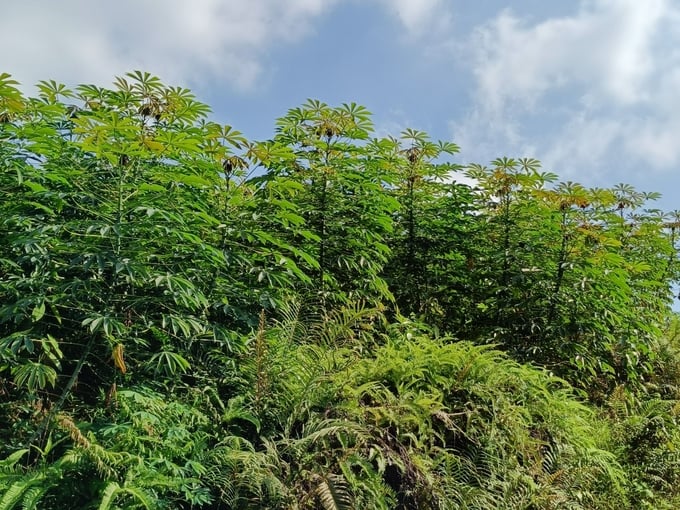
Cassava is a key export commodity for Vietnam. Photo: Thanh Tien.
In 2014, the Root Crop Research and Development Center, a subsidiary of the Field Crops Research Institute, collaborated with CIAT to enhance livelihoods through demand-driven interventions for competitive RTB production and processing, complemented by the development of cassava varieties Sa21-12, Sa06, and BKA900. Additionally, the Center has collaborated with the Cassava Program on hybrid breeding and evaluation since 2018.
From 2018 to 2020, the Plant Protection Research Institute collaborated with CIAT to implement a sustainable cassava production system that prioritizes pest management in Vietnam, Cambodia, and Thailand. From 2020 to 2023, the Institute continued this collaboration to develop and implement diagnostic protocols, tools, and information platforms for monitoring and certification.
During a meeting with Newby Jonathan, Cassava Program Leader at CIAT, Deputy Minister of Agriculture and Rural Development Hoang Trung expressed a desire for continued collaboration. He requested CIAT to coordinate with the Ministry and other local agencies to strengthen efforts in developing cassava varieties, including building a database of cassava varieties and germplasm; supporting breeding programs for disease-resistant and high-yield varieties; and providing disease-resistant cassava germplasm from international sources.
Furthermore, the Deputy Minister expects both parties to focus on improving the clean seed production process at the farm level and expanding clean seed production models. Additionally, stakeholders are recommended to develop and review Vietnamese standards for cassava varieties, including testing and quality standards.
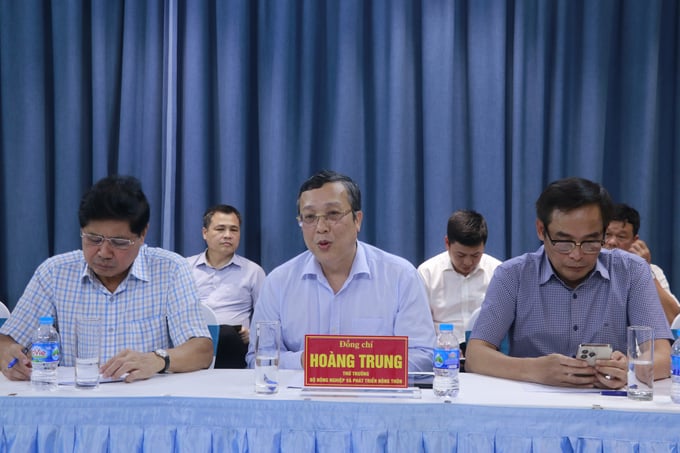
Deputy Minister of Agriculture and Rural Development Hoang Trung expressed a desire for CIAT to continue collaborating with the Ministry and other local agencies in the development of the cassava industry. Photo: Thanh Tien.
On the other hand, stakeholders must focus on developing and expanding production processes that are suitable for different ecological regions and terrains, especially sloping land. Notably, they must promote both yield and quality in addition to maintaining soil health in cassava production areas.
Stakeholders will also develop a monitoring and early warning system for cassava pests and diseases, which will be complemented by the enhanced use of information technology for pest prediction and forecasting; research and develop biological control methods, including the use of natural enemies and beneficial microorganisms to manage disease outbreaks; research integrated scientific solutions to combat soil-borne diseases affecting cassava in Vietnam.
Stakeholders will continue the development and transfer of cassava production technology; develop training materials on farming practices, management processes, and seed production for local farmers, businesses, and management officials.
Program Leader Jonathan emphasized the need for a sustainable cassava development strategy, with suitable planning guidelines for each ecological region. He highlighted cassava as a crucial source of livelihood for vulnerable groups, the disadvantaged, and smallholder farmers. Consequently, CIAT advocates for international donors to invest in improving livelihoods for these communities.

Newby Jonathan, Cassava Program Leader at CIAT, has pledged to continue supporting the development of Vietnam's cassava industry. Photo: Thanh Tien.
Regarding pest and disease management for cassava, Program Leader Jonathan advised relevant authorities and local governments against importing unidentified cassava varieties, notably African varieties, as they have the potential to spread viruses that can devastate production areas, causing significant damage.
He emphasized the importance of the Vietnam's cassava industry and market on a global scale. Moving forward, CIAT will maintain close cooperation with the Ministry of Agriculture and Rural Development, relevant agencies, and local governments to implement sustainable development solutions. Continued research and testing of new cassava varieties with high yield, quality, and disease resistance will also be a priority.
Translated by Nguyen Hai Long
![Turning wind and rain into action: [7] Early disaster warnings help marine farmers minimize losses](https://t.ex-cdn.com/nongnghiepmoitruong.vn/608w/files/news/2025/06/17/z6704423696987_15fd32ffc26d590d204d520c9dac6786-nongnghiep-142942.jpg)
(VAN) In recent years, thanks to early disaster warnings and forecasting, marine farmers in Khanh Hoa province have been able to reduce risks and losses, thereby improving production efficiency.
![Turning wind and rain into action: [6] ‘Four on-the-spot’ disaster management software](https://t.ex-cdn.com/nongnghiepmoitruong.vn/608w/files/news/2025/06/17/e5a48259d6a262fc3bb3-nongnghiep-183800.jpg)
(VAN) By simply activating the scenario on the disaster management software, the relevant authorities immediately know how many households need to be evacuated, where to evacuate them to, and by what means of transportation…
![Turning wind and rain into action: [5] Hue applies modern technology in disaster forecasting](https://t.ex-cdn.com/nongnghiepmoitruong.vn/608w/files/news/2025/06/17/z6704423696987_15fd32ffc26d590d204d520c9dac6786-nongnghiep-093938.jpg)
(VAN) In Hue city, modern technology has recently been applied in meteorological and hydrological forecasting and warning, helping to reduce the damage caused by natural disasters.

(VAN) A cutting-edge farming technique being implemented on an experimental ranch in Arizona's Sonoran Desert has already saved a billion gallons of water over five years, according to Civil Eats.

(VAN) Poultry and pig production and the environment can be boosted through enhanced water technology, according to new research.
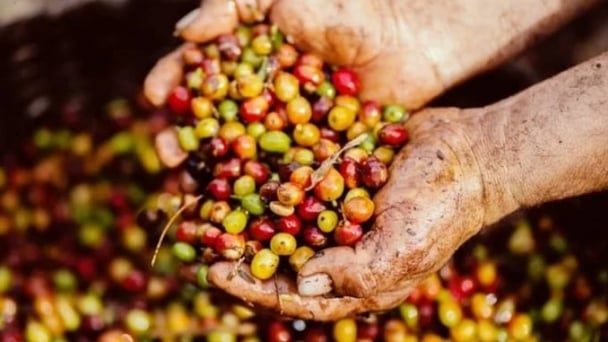
(VAN) Coffee prices on June 16, 2025 are unchanged. In Vietnam, local trading prices are holding steady, ranging around VND 112,000 – VND 112,500/kg.
![Turning wind and rain into action: [4] Bringing climate bulletins to remote and isolated areas](https://t.ex-cdn.com/nongnghiepmoitruong.vn/608w/files/linhnhp/2025/06/14/1152-z6704423696987_15fd32ffc26d590d204d520c9dac6786-nongnghiep-151141.jpg)
(VAN) The Vietnam Agriculture and Nature Newspaper interviewed Mr. Vu Thai Truong, Acting Head of Climate Change and Environment at UNDP Vietnam, to gain deeper insight into how climate bulletins are delivered to farmers.